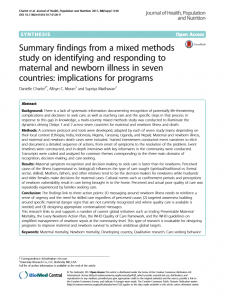
There is a lack of systematic information documenting recognition of potentially life-threatening complications and decisions to seek care, as well as reaching care and the specific steps in that process. In response to this gap in knowledge, a multi-country mixed methods study was conducted to illuminate the dynamics driving Delays 1 and 2 across seven countries for maternal and newborn illness and death.
A common protocol and tools were developed, adapted by each of seven study teams depending on their local context (Ethiopia, India, Indonesia, Nigeria, Tanzania, Uganda, and Nepal). Maternal and newborn illness, and maternal and newborn death cases were included. Trained interviewers conducted event narratives to elicit and document a detailed sequence of actions, from onset of symptoms to the resolution of the problem. Event timelines were constructed, and in-depth interviews with key informants in the community were conducted. Transcripts were coded and analyzed for common themes corresponding to the three main domains of recognition, decision-making, and care-seeking.
The findings link to three action points: (1) messaging around newborn illness needs to reinforce a sense of urgency and the need for skilled care regardless of perceived cause; (2) targeted awareness building around specific maternal danger signs that are not currently recognized and where quality care is available is needed; and (3) designing appropriate contextualized messages.
This research links to and supports a number of current global initiatives such as Ending Preventable Maternal Mortality, the Every Newborn Action Plan, the WHO Quality of Care framework, and the WHO guidelines on simplified management of newborn sepsis at the community level. This type of research is invaluable for designing programs to improve maternal and newborn survival to achieve ambitious global targets.